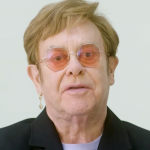Wellness is the concept of getting and staying healthy by taking care of your body and your mind. Taking your meds, getting regular exercise, maintaining a balanced diet and meditating can all help you achieve wellness. For many HIV-positive people, wellness also involves taking care of your spirit through faith.
Robert (Chodo) Campbell credits his Buddhist faith as a major contributor to his wellness. Originally from the United Kingdom, Chodo (his Buddhist name) was baptized in the Church of England, but religion was not a part of his upbringing. Growing up gay and dealing with abuse impacted him—and his beliefs—profoundly.
Chodo launched his career as an art director in fashion and photography in London. He moved to New York City to open a branch office for his employer in 1983, the year Chodo believes he became HIV positive. He owned his own creative services company by 1988, the year he was diagnosed with HIV. All the while, he immersed himself in the gay party scene until drugs and alcohol took over his life.
Years after getting sober, in 1993 he started practicing Buddhism. He joined the Village Zendo, a Buddhist community with many gay practitioners. In 2002, he began studying formally to become a Buddhist monk. He was ordained in 2005.
Today, Chodo is the co-founder and co-executive director of the New York Zen Center for Contemplative Care along with Koshin Paley Ellison, a Buddhist monk who also is Chodo’s husband. Honoring Buddhist principles, the center seeks to transform suffering through a chaplaincy program, educational retreats and other outreach.
Chodo also works with the Robert Mapplethorpe Residential Treatment Facility, which provides assisted living for people with HIV/AIDS. Total wellness is the overall goal of all his work.
I visited with Chodo at the Village Zendo, which is located in downtown Manhattan. As an HIV-positive person on my own journey to wellness, I was inspired by his energy and his insights. I also was challenged when he guided me through a hands-on introduction to Zen meditation.
How does Buddhism inform your perspective on wellness?
In Buddhism, we talk about [how] the only thing that we really have is this moment. And in [each new] moment, I have an opportunity to take care of myself, to notice my body, to notice my environment, to be aware of everything.
If I’m totally aware, I’ll notice when I’m not feeling well. I’ll notice when something’s off with my diet, with my bowel movements, my thoughts, my [level of] anxiety, my temperament. I have an opportunity, through my meditation practice, to just keep coming back to the moment, [to understand] what’s going on right now [with my whole being].
How does meditation help improve wellness?
Meditation [helps] to bring us to that place of stillness. When we’re in that place of stillness, we’re in a much better position to notice what is out of whack, what is off kilter. We can’t do that unless we’re paying full attention to ourselves.
We talk about the mind and body being one thing—there’s no separation. If we take care of the mind, we’re taking care of the body. If we take care of the body, we’re taking care of the mind.
I [want] the last word [on my health] to be mine; I want that to come from a place that is calm and centered and true. The only way I can get to my true essence is through meditation.
How do you integrate the advice of doctors and other health care providers in your plan for wellness?
I’ve been HIV positive now for 26 years. When I was first diagnosed, my doctor at the time recommended that I go on a drug called AZT. My [CD4] cells were very low, and I said I really didn’t want to go on AZT.
We were hearing so much about its side effects [like how it affected bone marrow], and people were dying. I said, “I don’t want to do that.” My doctor said, “Given where your numbers and your blood work are, you’re looking at 24 months to live.”
Then, AIDS was still a very new disease. We still didn’t know enough about it, but I knew I didn’t want to take an experimental drug.
My doctors never have the last word on my health. I also use my therapist, and my Buddhist teacher, to help inform me. I take all the information, process it and come from a place—not only of intellectual understanding—but [also] a place of real deep intuition.
What’s kept me healthy for the last 26 years is to not believe that the doctor—or anyone else—has the last word [on my health].
How do you apply your perspective on wellness to the day-to-day task of taking care of yourself?
I’m not anything other than a human being with my faults, my pathology, my fears. There are moments when I do forget to take care of myself. In my [Buddhist] practice, we talk about how we can separate from ourselves. When I separate [from myself], I can neglect what’s going on in me. I can not pay attention to my bad mood or I can not pay attention to how tired and exhausted I get because I’m constantly running.
As a caregiver and as a person that trains people to give care to others, one would think my first duty to myself would be to take care of myself, but in fact it’s difficult. My meditation practice is a way that I can be reminded [to be healthy]. [Daily] I can bring myself back to a cushion to remind myself that I need to take care of Chodo.
Speaking of taking care of Chodo, you already have overcome many hurdles in your life. How has learning to overcome them supported your sense of well-being?
I arrived at Buddhism through sobriety. I had been sober for five years and was actually not doing well. Though I was sober—I had no impulse to drink or to go back to [using] cocaine—I was feeling spiritually bankrupt. I met a Buddhist monk during one of my therapy supervisions, and she guided me to the practice.
I had real difficulties in coming to terms with my whole life prior to getting clean and sober. It was very painful. There was a lot of stuff I didn’t want to look at, and I was actually still living in it as though it were happening, as though the trauma was still happening for me.
Through my Buddhist practice, I realized that I could be in a place of knowing that yes, traumas did take place, abuse did take place, my addictions did rule my life for many years—and yet I could change that.
I think the very first time I sat on a meditation cushion was the first time in my life that I actually stopped running—both physically and mentally. I was able to listen to the constant chatter in my mind, the constant negative thoughts, the constant craziness that seemed to run my life.
It was really difficult for me during the first year—coming back to the cushion, just sitting there. I was told to sit with whatever came up—whatever anger, whatever sadness, whatever fears, whatever joy—to just sit with the feelings, to not attach the story, to simply experience them.
My stories had kept me from my peace, my true center. After 15 years, I still have those stories, but now they’re not running the show quite so much.
Could you explain further what you mean by “stories”?
We have the actual event that took place. Then there’s our interpretation of the event and the “story” we build around it. The “story” is something that we continue to carry.
[For instance,] the event has happened. [He taps the table loudly.] That’s the event. Next week, [you may tell yourself a story that starts] with, “Oh my God, when he tapped that table, it made me jump. I can’t stand it, it makes me so frightened.” You will then continue to live out of that story, so it becomes bigger. [Your remembrance is] no longer the event, it’s the story.
If I’m an adult living in the story of what happened to me when I was 5 years old, it’s not really serving me. It’s not to make the 5-year-old’s event any less important or traumatic, but [Buddhist meditation] gives me an opportunity to move away from that. I’m not going to live in that trauma anymore.
In addition to Buddhism, what else has helped you get to a place of wellness?
I’ve had many years of psychotherapy, and I’m still in psychotherapy. I don’t think there’s ever going to be an end to my psychotherapy. Just as in my Buddhist practice, my story, my life, is always evolving. I started in therapy when I was 34 years old, and I got sober a year later. I’ve been sober for 22 years.
Support groups for people who have gone through similar traumas, whether it’s sexual abuse, drug abuse or other events or traumas, are important.
I could not have worked [successfully through] the 12 steps of Alcoholics Anonymous or Narcotics Anonymous without my therapy. My therapy is enhanced by my Buddhist practice, and my Buddhist practice is informed by my therapy. It all works in tandem; I don’t separate any of them out. I need them all.
Assisting people who are going through the process of dying is part of your daily practice. Why is it important for you to do that work?
Many people who come through alcoholism or drug abuse will tell you that suddenly they feel alive. For many years, they had felt dead or anesthetized.
I anesthetized myself for years with drugs and alcohol. When I got sober, I felt alive. On some level, I [had already] experienced death. More importantly, I experienced a rebirth because I felt for the first time that I was actually alive.
I had no idea what I was going to do with this new life that I had found. In Buddhism, we talk a lot about service to others, which is something I had never really done in my life.
I started volunteering in a hospice, and it was one of those light-bulb moments. For me, it’s very profound work. It’s a great honor to be with anyone that is dying. It reminds me constantly how fragile life is, how fragile we all are. It keeps my life real for me.
How is wellness connected with death and dying?
You can’t live a whole life without embracing the fact that you’re going to die. We live in this world of denial. We live in a culture that doesn’t face death. We live in a society that pushes death to the side. We put our aged in nursing homes; we don’t speak about [diseases like] cancer or HIV/AIDS.
You’re born, you’re going to die. To live in denial of that is deprivation, which is not wellness. It’s not wholeness. It’s not looking at our life span as a whole. We’re not looking at the decline of our health, whether it’s through AIDS or any kind of disease, or just through the natural aging process. [Life is] inevitably going to bring you to the point of death.
Your New York Zen Center for Contemplative Care also plans to provide end-of-life care. Can you elaborate on that?
From my volunteer experience in hospices, I went on to train as a hospital chaplain. My partner [Koshin], who’s also a Buddhist practitioner, felt that there was a real need for Buddhist practitioners in the field of health care, especially hospice care.
We co-created the New York Zen Center for Contemplative Care and a program that trains caregivers from a Buddhist perspective. It’s a contemplative perspective. We now have 65 students.
They’re from all walks of life. They’re hospice workers, doctors and nurses, retired school teachers, ministers. They either want to enhance the work they do through contemplative practice, or they just want to experience a different way of doing it.
It’s really important to us that people, whether they’re sick or dying, are allowed to be treated with dignity, respect and have a spiritual experience [in the final days and moments of] their lives.
Our idea is to create a building that will house end-of-life suites and studio apartments. It’s not so much hospice, [but rather] it’s end-of-life care. The hospice component will be [handled by] a third party brought in for certain treatments. [Our place will be] a place where people can come and begin that journey toward the end of their life.
On your website there’s a wonderful short documentary titled “Center for Contemplative Care: A Film” that features a woman named Rose Tisnado. Can you tell us about her?
I met Rose through another Buddhist practitioner who was a great friend of hers. Rose was given six months to live. She had been diagnosed with cancer, and she was very scared.
Rose heard about my work through our mutual friend. She wanted to meet me to see if we could work together just in doing meditation practice to bring her to a place of calmness.
When I first met Rose, I was immediately struck by her life force. Even though, at that point, we thought she had only six months to live, she was very much alive. She was very clear that she didn’t want to do chemotherapy, she was ready to go toward the end of her life, but she needed to be in a very different place [emotionally and spiritually].
She wanted to be calmer; she wanted to understand what [death was] going to be like. There was fear around the actual journey toward death. In my work with Rose and many other people, we recognize that [when you’re dying] there’s no time for bullshit. There’s no time to not speak truthfully.
Many people have issues that are unresolved. They don’t feel they can speak about [them] with their families, their spouses, their partners. In our work, we create a wonderful space for people to open up to who they really are. It’s not always pretty. Not everybody dies a great death. But Rose was willing to go to those places where her demons lived.
We had many conversations about her lifestyle and about her fears about the people that perhaps she had not been so kind to in her life. We did some very intense meditations on dying, what it would be like, the dissolution of the body.
There’s a meditation that we do in our practice, “The Nine Contemplations,” about what’s it going to be like when you die. Nothing’s going to stop that, not your friends or your money.
Any final thoughts you’d like to share?
I’m lucky enough to still be living with HIV after 26 years. There’s no judgment on my part; each of us lives our lives how we see fit. I’m not saying that the way I live my life is the only way to do it.
[My life] could have gone any way with my drug addiction, with the choices I made. I could easily have wound up in a residence [for people dying from AIDS], but [thanks to facing my past and changing how I lived my life] I didn’t.
If a person chooses to place his or her life entirely in the hands of the medical profession, then that’s his or her way. We each find our own way. There’s no right way, there’s no wrong way. There’s just the way that each of us chooses to do it.
Visit zencare.org to watch “Center for Contemplative Care: A Film.”







1 Comment
1 Comment